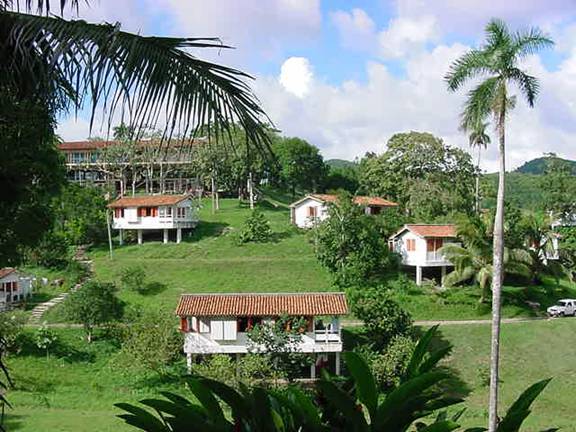ABOUT LAS TERRRAZAS
by Karen Lee Wald

From: Karen Lee Wald
Sent:
Subject: Las Terrazas gets even better
A LETTER TO A FRIEND
ABOUT
LAS TERRRAZAS
by Karen Lee Wald

From: Karen Lee Wald
Sent:
Subject: Las Terrazas gets even better
Many of you have heard me talk about Las Terrazas, have written things I
wrote about it, or gone there with me. (For those who have missed this, see copy
of old letter below,
along with a photo of the village and one of me enjoying the waterfall). Now,
according to my friend Maria Carla, things are getting even better, if that's
possible. Because Las Terrazas is in the middle of a biosphere reserve,
they have been VERY careful about any expansion, to make sure it is consistent
with the original goals of preserving and restoring forests and nature areas. So
news of any kind of expansion is pretty special.
[...]
they doubled the space on el río San Juan, to the left of the bridge there is
now a big cascade with a natural 1.5 meter-deep pool and cafeteria; Tito,
remember him from el Jardín Botaníco's first vegetarian restaurant?,
has opened a similar one right next to el taller de sirografía [the silkscreen
workshop], AND the architect is enlarging the hotel, but not in the traditional
way: he is slowly building "an extra special room" in four of the
local residents' apartments in Las
Terrazas (the first one to be chosen was--of course--Margarito, the first
mayor [one of the "village elders" --part of the first group to move
into Las Terrazas in the early 80s-kw]):
I visited this first room that has [growing in it], among other things, a mango
tree Margarito planted when he moved there, that comes out right next to the
shower, crosses half the room, goes out the roof and is again visible from the
window looking toward the hills; the door to the bathroom was done by[famous
Cuban artist who lives in Las Terrazas] Duporté in stained glass,
and one of the decorative elements has been painted in a 6-inch strip running
all around the room at hip length more or less. There is a new taller [crafts
shop] where they make bamboo furniture now used in these rooms and
of course giving young people a place to work....
Anyway,
those who have been to Las Terrazas may want to visit it again. Those who
have never been there should include it in their next trip. It is just over the
Habana-Pinar
One of
the best places I’ve been for environmentally-conscious tourism is the
community of Las Terrazas, in
I should add a little about Las Terrazas community itself, because it
represents the essence of what the Cuban Revolution was all about in 1959, and
what it still is to many people, especially in the rural areas. In the 1960s a
main objective of Fidel Castro and other revolutionary leaders was to see to it
that the benefits of the revolution
reached the most remote corners of the country, where the quality of life had
changed little for centuries, and people were just eking out a bare
living—often unaware of what was going on in the world outside.
The idea was to convince these small peasant farmers (campesinos), who
usually lived in dirt-floor, thatched-roof “bohios” with no
electricity, plumbing, etc, and no schools or medical services anywhere near
them, to move closer together, to form small villages or farm coops, so that
all these services could be brought in. (That was harder than it might sound,
since the first Agrarian Reform instituted by the Revolution had just given the
campesinos title to the land they worked on, and it wasn’t easy to
convince them that they would be better off leaving it or pooling it.)
At the same time, provincial leaders were asked to pinpoint what the main
problems were in their areas (remembering that
In the Sierra del Rosario area of
There had been major deforestation in the 19th century by the French
colonial coffee plantation owners (who sought refuge in
To turn this around, they proposed terracing the mountainsides (the Sierra
del Rosario is mainly low foothills, not steep rocky mountains) and engaging in
major reforestation efforts along these terraces. That in turn would help stop
the erosion and restore the ecosystem.
Then, there was a need for housing both for the campesino families whose
homes and land were in the areas to be reforested, and for the families of the
workers who came in from other areas to help build the terraces and—along
with the local residents—take part in the reforestation program.
Thus, “Las Terrazas” came about—now a community of nearly 1000
residents in a picturesque village winding along the terraces overlooking a
lake created by the damming of the San Juan River.
Their primary work was, and is, reforestation. But now, with economic
hard times hitting the country, making the costly reforestation program
difficult to carry out on the same massive scale as before, an ecotourism
resort has been carefully introduced to provide additional employment and
income for the village without negatively affecting the ecological priorities
of the area.
Everyone in the world of ecotourism talks about the objective of establishing
positive relations between the eco-resort and the local community, involving
the community in planning and assessment, and support of the local economy, but
it is almost never accomplished.
Here the interaction is total. The community was consulted and educated
beforehand and approved the project. The community is ALREADY benefitting (even
before UNECA, the Cuban construction enterprise that built the place, is paid
back its investment) in numerous ways, not least of which is that it gets 40%
of Moka’s profits and an additional 10% goes to health care in Las
Terrazas.
The Las Terrazas Tourism Complex, which includes Moka, is Las Terrazasnow the
second biggest employer in Las Terrazas (the forestry plan is still
number one). Almost ALL of Moka’s workers live in Las Terrazas.
The hotel provides additional food, medicine, and other supplies for the
village. Visitors are often moved to make donations to the
school, childcare center, health clinic or ecology center.
A number of tourist-oriented home enterprises have sprung up—you can get
typical Cuban food prepared in Mercedes’ kitchen, or sweet black Cuban coffee
brewed at Maria’s place; local craftsmen have set up silk screen,
wood-carving, ceramics and recycled paper workshops. The income from sales are
divided 40% to the individual artists and 60% to the community
Best of all, everything Moka is providing is going to a community whose very
existence came about through an ecological project of reforestation that is
still going on today, and that will continue to the extent that the tourism
complex is able to keep the community going. The terracing of the mountains and
planting of native species that had been destroyed in the area not only has
brought back the trees, but by halting the erosion, has also brought back most
of the original flora and fauna that had been driven out of the area by last
century’s deforestation. All of this is overseen by the Academy of Sciences
Ecology Research Station which monitors the Biosphere Reserve that Las
Terrazas is located in.
It is one of the only ecotourism projects I’ve seen where ECO (in the sense
of both people and nature) really does come first. Las Terrazas provides
a model in which women and men are as
important as the trees they plant and nurture, where each serves the other. As
such, it is one that people around the globe could learn from.
